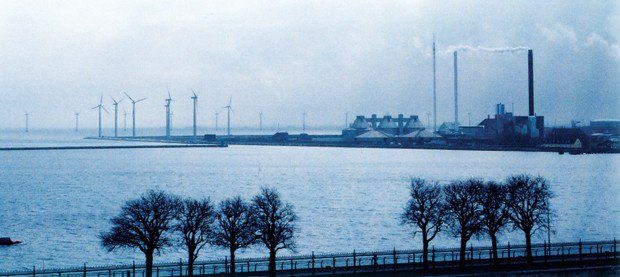
Thermal plants and windmills at Copenhagen harbour. Photo: Odd Iglebaek
Since de-regulation the market's transmission and inter-connector capacity has been expanded. Measured in consumption terms (TWh) inter-Nordic transfers accounted for 4.8 percent in 1995. By 2005 the proportion had almost doubled to 9.0 percent (Source: Nordel Statistics 1995 and 2005).
Throughout the liberalisation process, the Nordic power market has been granted general political support from the national authorities and from the Nordic Council of Ministers. This consensus over de-regulating the market may be one of the main reasons why the Nordic power market remains a "best case" example compared to other de-regulated power markets.
It has been suggested that the high level of state ownership in the Nordic energy market has led to more responsible market behaviour in respect of the overall security of supply.
With the exception of Fingrid and Fortum in Finland the largest national actors in the Nordic energy market, that is to say, Stanett and Statkraft in Norway, Svenska Kraftnät and Vattenfall in Sweden and Energinet.dk in Denmark, are owned by the Norwegian, Swedish and Danish states respectively. On the other hand, in for example California or the England-Wales market, the main assets were privatised at the onset of liberalisation.
On the supply/production side of electricity the Nordic market is blessed with a huge proportion of hydro power, which is cheap and clean. On the negative side, this means that the Nordic market, especially Norway, is sensitive to variations in rainfall. A very dry year will make the Nordic region dependent on imports from continental Europe and/or Russia, and this will typically lead to higher electricity prices. Indeed, even the possibility that this may occur, some time in the future, results in higher prices – as a sort of insurance premium.
Hydro power is not sufficient to meet all demand in the Nordic region and the remainder is produced by a mix of nuclear, fossil fuels and renewable generation.
As a large proportion of continental Europe's energy is generated by the burning of fossil fuels the price of fossil fuels is clearly an important driving factor also for Nordic power prices. In 2006 fuel prices reached new highs, thus contributing to higher energy prices in the Nordic market.
Because the Nordic market is interconnected with the continental power markets, a "spill-over" effect on prices occurs: High power prices on the continent will typically lead to a heightened price in the Nordic market. As a large proportion of the power in continental Europe is fired by fossil fuels, the price of fossil fuels is clearly also a defining factor for Nordic power prices.
By Vivi Mathiesen, Senior Adviser, Nordic Energy Research - www.nordicenergy.net